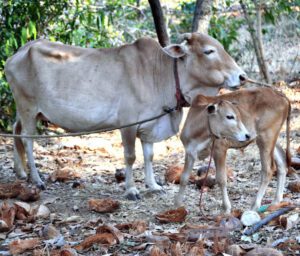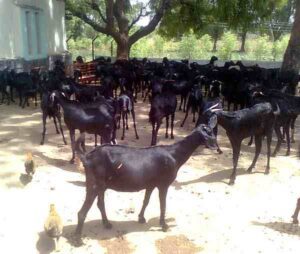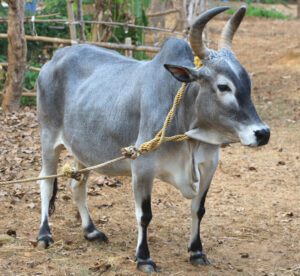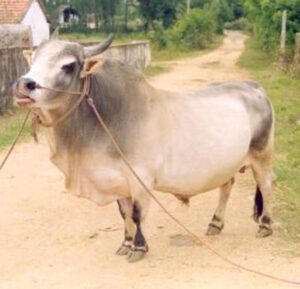The Rathi cattle is an important breed of cattle indigenous to India. It is a milk cattle breed and primarily used for milk production and for draft purposes. The breed is pretty popular in it’s native area.
Rathi cattle are a Bos indicus breed originated from Bikaner, Ganganagar and Hanumangarh districts in northwest Rajasthan, India. It is a very important dual purpose breed of cattle of India which is well known for it’s milking and draught prowess.
The breed is locally known to have two variants, which are Rathi and Rath. The Rathi cattle are a draft breed, and the Rath is a pure milk producing variant.
The Rath cattle were domesticated by Rath tribe and the variant originated in the Alwar district of Rajasthan. White skin with black or grey spots are the main characteristics of the Rath cattle.
While the Rathi cattle are usually of brown color. The Rathi and Rath are two completely separate breed. The Rathi cattle originated from the Sahiwal and Tharparkar cattle breeds.
Currently the breed is available throughout Rajasthan and some other parts of India. Read more information about this cattle breed below.
Rathi Cattle Characteristics
The Rathi cattle are medium sized animal which are usually brown in color with white patches all over the body. Although they are also found in completely brown or black coat with white patches.
Their lower body parts are usually lighter in color as compared to the rest of their body.
They have medium sized horns, and their horns are curving outward, upward and inward. Their face is broad between eyes and slightly dished. They have long tail, and the dewlap is fine and loose. Average body weight for bulls is 350-400 kg and cow is 280-300 kg. Photo and info from Wikipedia.

Housing
Making a good housing facility or shelter is very important for raising cattle. Fortunately, housing requirements of these cattle is very simple. They will be happy if you can arrange the basic housing requirements for them. Try to keep the house dry and clean it on a regular basis.
Feeding
Food requirements of these animals are simple. Although, feeding them with good quality and nutritious food will help them to stay healthy and happy. So, try to feed them with good quality food.
Breeding
The Rathi cattle are naturally very good breeders. They will breed easily without human intervention if you keep just one bull in your herd.
Caring
Rathi is a very strong and hardy cattle breed. These animals generally require less caring and other management. Although, taking additional caring will help them to stay healthy, active and productive. Arrange a good shelter for them, feed them good quality and nutritious food, and always try to monitor their health on a regular basis. And keep good contact with a vet, so that you can call him/her during emergencies.
Uses
Rathi cattle are dual purpose animals. They are used for both milk production and for draft purposes.
Special Notes
Rathi cattle are very hardy animals. The eco system in it’s native tract is fragile and the lands are less fertile with very low productivity. Chilly winter, dry monsoon, dust storms and scorching summer are the characteristics of the region.
However, these animals are well adapted to this area and can produce well in this environment. The cows are efficient and good milk producers.
On average the cows can produce about 1560 kg of milk per lactation. Although their milk production can vary from 1000 to 3000 kg. Review full breed profile of this breed in the following table.
| Breed Name | Rathi |
| Other Name | None |
| Breed Purpose | Milk, draft |
| Special Notes | Very hardy and strong, well adapted to it’s native environment |
| Breed Size | Medium |
| Milk Production | Vary from 1000 to 3000 kg (average 1560 kg) |
| Climate Tolerance | All Climates |
| Coat Color | Mainly brown with white patches all over the body |
| Horned | Yes |
| Milk Yield | Good |
| Rarity | Common |
| Country/Place of Origin | India |







[email protected] no,,918106953318,Hyderabad,500089,Telangana, India,sir, can u provide complete descrption and thier ecosystem, location, charecteristics of high land,romagnola,pingauer and murboden cattles.